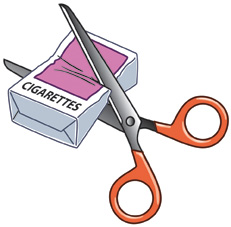How to Quit Smoking
Smoking is a hard habit to break. About half of all people who've ever smoked have been able to quit. Most people who still smoke want to quit. Here are some of the best ways to stop smoking.

Keep in mind how quitting can help your health
The health benefits of quitting start right away. They keep improving the longer you go without smoking. Knowing this can help inspire you to stay on track. These benefits occur at any age. Quitting is a good choice whether you are 17 or 70. Some of the health benefits after your last cigarette include:
-
After 20 minutes. Your blood pressure and heart rate return to normal.
-
After 12 to 72 hours. Your carbon monoxide levels in your blood return to normal.
-
After 2 days. Your ability to smell and taste start to get better as damaged nerves regrow.
-
After 2 weeks to 3 months. Your circulation and lung function get better.
-
After 1 week to 9 months. You have less coughing, congestion, and shortness of breath. You feel less tired.
-
After 1 to 2 years. Your risk of heart attack goes down by 50% compared to a user of cigarettes or tobacco products.
-
After 10 years. Your risk of lung cancer goes down by 50%.
-
After 15 years. Your risk of stroke becomes the same as a nonsmoker.
What about going cold turkey?
You may have heard about quitting "cold turkey." This means stopping all at once. Going cold turkey is a choice. But it's not the most successful way to quit smoking. Trying to cut back slowly often doesn't work as well either. This may be because it continues the habit of smoking. You may also inhale more smoke while smoking fewer cigarettes. This leads to the same amount of nicotine in your body.
But quitting cold turkey or cutting back slowly aren't your only choices. Using tobacco cessation medicines with behavioral counseling may be a better choice to help you succeed. Talk with your health care provider about your choices for support while you quit smoking.
Get support
Support programs can be a big help, especially for heavy smokers. These groups offer information, ways to change behavior, and peer support. Ask your health care provider for some resources. Here are some other ways to find support:
Support at home is important too. Family and friends can offer praise and reassurance. Ask your friends who smoke to support your decision. Try to stay away from situations that set off the desire to smoke. This may include smoking with your morning coffee. Or smoking after a meal. Create new routines to help decrease your cravings.
If the smoker in your life finds it hard to quit, encourage them to keep trying. Remind them of all of the benefits to themselves and people they love.
Try over-the-counter nicotine replacements
Nicotine replacement therapy may make it easier to quit. You can buy some aids without a prescription. These include a nicotine patch, gum, and lozenges. But it's best to use these under the care of your health care provider. The skin patch gives a steady supply of nicotine. Nicotine gum and lozenges give short-time doses of low levels of nicotine. Both methods reduce the craving for cigarettes. If you have upset stomach (nausea), vomiting, dizziness, weakness, or a fast heartbeat, stop using these products and see your provider.
Ask about prescription medicine
After reviewing your smoking patterns and past attempts to quit, your health care provider may offer a prescription medicine. These include bupropion, varenicline, a nicotine inhaler, or nasal spray. Each has advantages and side effects. Your provider can go over these with you.
Keep trying
Most smokers try to quit many times before they succeed. It’s important not to give up.